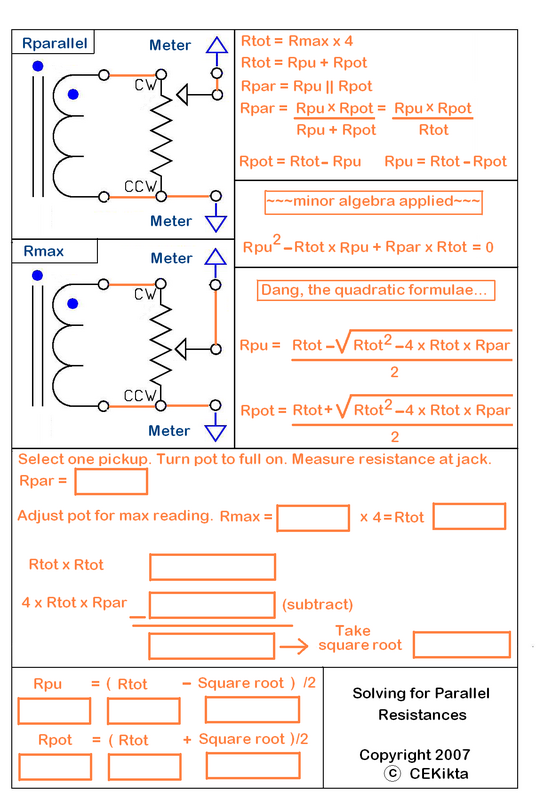Post by ChrisK on Oct 31, 2007 19:36:43 GMT -5
or Discerning Paralleled Resistances as previously titled
So, I bought this dual humbucker guitar with 1 volume and 1 tone pot per pickup (like an LP for instance) and wanted to discern its innards without taking anything apart.
While one can measure the parallel combination of each pickup and its volume pot (the tone pot circuit is assumed to be out of circuit due to the series capacitor), one cannot determine the individual values of the pickup or volume pot.
Or can they?.....!
If one selects only one pickup, turns the volume pot fully up/on, and measures the resistance at the output jack, one gets Rparallel or Rpar. This is Rpot || Rpu. (Rpot * Rpu / [Rpot + Rpu].)
If one then adjusts the volume pot for the maximum reading obtainable, one gets Rmax, the parallel combination of part of the volume pot in parallel with [the other part of the volume pot in series with the pickup]. (This is a math'ish statement.)
Rmax multiplied by 4 (Q.E.D) is equal to Rtotal (or Rtot), the resistance of the pot + the resistance of the pickup.
So, we can measure the following;
Rmax, which gives us Rtot
Rpar
Through the use of algebraic manipulation and formulaic prestidigitation, we CAN discern "stuff".
(More brain surgery thru the nostrils..... )
)
BTW, this can be used on a Strat or Tele-type( ;D) guitar with one volume pot. Just select one pickup at a time, you should get the same value for the common volume pot (if you don't, your Ohmmeter sucks).

For proof of concept, use;
Rtot = 540K
Rpar = 8K85
One should get;
Rpu = 9K
Rpot = 531K
Proof
(531 * 9) / (531 + 9) = 8K85
As an observation, Rtot / [Rtot - Rpar] ~= Rpu / Rpar
or
Rpu ~= Rpar x Rtot / [Rtot - Rpar]
8K85 x 540K / 531.15 = 8K998 (0.022% error)
and
Rpu ~= Rpar / Rtot / [Rtot + Rpar]
8K85 / 540K / 548K85 = 8K995 (0.056% error)
Dang close!
Let's try a Strat with a hot bridge pickup;
Rpot = 175K (low end of tolerance)
Rpu = 20K (it's hot!)
Rtot = 195K
Rpar = 17K95
Rpu ~= Rpar x Rtot / [Rtot - Rpar]
17K95 x 195K / 177K05 = 19K77 (1.2% error)
and
Rpu ~= Rpar / Rtot / [Rtot + Rpar]
17K95 / 195K / 212K95 = 19K602 (2% error)
Only close.
When the ratio of the pickup to the pot is smaller, the error from these simple calculations increases.
If we add the error between the two calculations to the larger valued calculation, we get real close.
8,998 - 8,995 = 3
8,998 + 3 = 9,001 (0.01% error)
and
19,770 - 19,602 = 168
19,770 +168 = 19,938 (0.31% error)
Most of the optimized calculations well exceed the accuracy of even a good volt Ohm meter. I have access to a $2,000 6 digit benchtop unit which I used for my initial measurements. My reasonably good personal one is only accurate to 0.5% overall.
Sermon
So, a couple of simple measurements will tell us all that we really need to know from a resistance perspective.
By purchasing a 1/4" male phone plug from Radio Shack (or where ever), connecting it to your digital volt Ohm meter, and plugging into the output jack (if your guitar has an input jack, backwards is) one can measure pretty much the entire switching and volume design of a guitar. Of course, the more churlish ones will take some intuition.
Also, by noting where the Rmax value occurs on the knob (such as in Strat or LP terms), one can tell the general taper of the pot. If Rmax occurs around "6" (on a scale of 0 to 10), it's likely linear, and if Rmax occurs around "8" it's likely audio. (If Rmax occurs around "2" it's likely reverse
So, I bought this dual humbucker guitar with 1 volume and 1 tone pot per pickup (like an LP for instance) and wanted to discern its innards without taking anything apart.
While one can measure the parallel combination of each pickup and its volume pot (the tone pot circuit is assumed to be out of circuit due to the series capacitor), one cannot determine the individual values of the pickup or volume pot.

Or can they?.....!

If one selects only one pickup, turns the volume pot fully up/on, and measures the resistance at the output jack, one gets Rparallel or Rpar. This is Rpot || Rpu. (Rpot * Rpu / [Rpot + Rpu].)
If one then adjusts the volume pot for the maximum reading obtainable, one gets Rmax, the parallel combination of part of the volume pot in parallel with [the other part of the volume pot in series with the pickup]. (This is a math'ish statement.)
Rmax multiplied by 4 (Q.E.D) is equal to Rtotal (or Rtot), the resistance of the pot + the resistance of the pickup.
So, we can measure the following;
Rmax, which gives us Rtot
Rpar
Through the use of algebraic manipulation and formulaic prestidigitation, we CAN discern "stuff".

(More brain surgery thru the nostrils.....
 )
)BTW, this can be used on a Strat or Tele-type( ;D) guitar with one volume pot. Just select one pickup at a time, you should get the same value for the common volume pot (if you don't, your Ohmmeter sucks).

For proof of concept, use;
Rtot = 540K
Rpar = 8K85
One should get;
Rpu = 9K
Rpot = 531K
Proof
(531 * 9) / (531 + 9) = 8K85
As an observation, Rtot / [Rtot - Rpar] ~= Rpu / Rpar
or
Rpu ~= Rpar x Rtot / [Rtot - Rpar]
8K85 x 540K / 531.15 = 8K998 (0.022% error)
and
Rpu ~= Rpar / Rtot / [Rtot + Rpar]
8K85 / 540K / 548K85 = 8K995 (0.056% error)
Dang close!
Let's try a Strat with a hot bridge pickup;
Rpot = 175K (low end of tolerance)
Rpu = 20K (it's hot!)
Rtot = 195K
Rpar = 17K95
Rpu ~= Rpar x Rtot / [Rtot - Rpar]
17K95 x 195K / 177K05 = 19K77 (1.2% error)
and
Rpu ~= Rpar / Rtot / [Rtot + Rpar]
17K95 / 195K / 212K95 = 19K602 (2% error)
Only close.
When the ratio of the pickup to the pot is smaller, the error from these simple calculations increases.

If we add the error between the two calculations to the larger valued calculation, we get real close.
8,998 - 8,995 = 3
8,998 + 3 = 9,001 (0.01% error)
and
19,770 - 19,602 = 168
19,770 +168 = 19,938 (0.31% error)
Most of the optimized calculations well exceed the accuracy of even a good volt Ohm meter. I have access to a $2,000 6 digit benchtop unit which I used for my initial measurements. My reasonably good personal one is only accurate to 0.5% overall.
Sermon
So, a couple of simple measurements will tell us all that we really need to know from a resistance perspective.
By purchasing a 1/4" male phone plug from Radio Shack (or where ever), connecting it to your digital volt Ohm meter, and plugging into the output jack (if your guitar has an input jack, backwards is) one can measure pretty much the entire switching and volume design of a guitar. Of course, the more churlish ones will take some intuition.
Also, by noting where the Rmax value occurs on the knob (such as in Strat or LP terms), one can tell the general taper of the pot. If Rmax occurs around "6" (on a scale of 0 to 10), it's likely linear, and if Rmax occurs around "8" it's likely audio. (If Rmax occurs around "2" it's likely reverse
audio.) (If you suspect that you have a reverse linear pot, I have my suspicions as well.......  )
)
I would recommend that this be done to every guitar in one's collection and documented for future issues. One only has to take the Rpar and Rmax measurements for all pickup combinations (don't forget the push pull switches) and calculate only when needed (or desired).
If the Rpar and Rmax measurements can be taken for individual pickups, the more convoluted schemes can often be discerned.
/Sermon
 )
)I would recommend that this be done to every guitar in one's collection and documented for future issues. One only has to take the Rpar and Rmax measurements for all pickup combinations (don't forget the push pull switches) and calculate only when needed (or desired).
If the Rpar and Rmax measurements can be taken for individual pickups, the more convoluted schemes can often be discerned.
/Sermon


